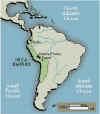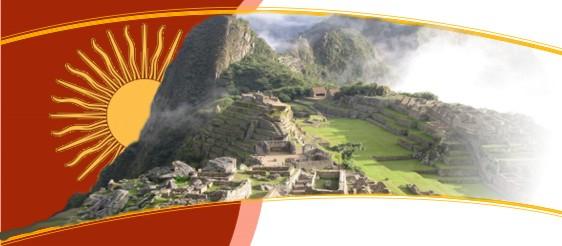|
The Spaniards met Atahualpa, the victor in the civil war, and
his army at a prearranged conference at Cajamarca in 1532. When Atahualpa
arrived, the Spaniards ambushed and seized him, and killed thousands of his
followers. Although Atahualpa paid the most fabulous ransom known to history—a
room full of gold and another full of silver—for his freedom, the Spaniards
murdered him in 1533.
The Spanish destroyed many of the irrigation projects and the
north-south roads that had knit the empire together, speeding the disintegration
of the empire. By November 1533 Cuzco had fallen with little resistance. In
addition, the indigenous population declined rapidly as a result of new diseases
brought by the Spaniards, diseases to which the Inca had no immunity. Members of
the Inca dynasty took refuge in the mountains and were able to resist the
Spaniards for about four decades. However, by 1572 the Spaniards had executed
the last Inca ruler, Tupac Amaru, along with his advisers and his family.
In 1535 Pizarro founded on the banks of the Rímac River the
Peruvian capital city of Ciudad de los Reyes (Spanish for "City of the
Kings"; present-day Lima). Subsequently, disputes over jurisdictional
powers broke out among the Spanish conquerors, or conquistadors, and in 1541 a
member of one of the conflicting Spanish factions assassinated Pizarro in Lima.
The Inca civilization had unified what are now Peru, Ecuador,
and Bolívia and created an integrated society. The Spanish, whose main aims
were plunder and the conversion of native tribes to Christianity, stopped the
development of the indigenous civilization. The Spaniards treated the Inca
ruthlessly, using their labor to produce the minerals needed in Spain. The
result was the creation of a psychic chasm between the Inca and the Europeanized
population, a chasm that has endured for more than 400 years.
The Spanish introduced a system of land tenure consisting of
European landlords and indigenous workers. This system succeeded in solidly
establishing a privileged and wealthy-landed aristocracy early in the colonial
period. Little was done to educate the masses of peoples. As a result, colonial
Peru was a divided society, consisting of a small class that owned the land and
controlled education, political, military, and religious power, and of a large,
mostly indigenous class (about 90 percent of the total population) that remained
landless, illiterate, and exploited.
In 1542 a Spanish imperial council promulgated statutes called
New Laws for the Indies, which were designed to put a stop to cruelties
inflicted on the Native Americans. In the same year Spain created the
Viceroyalty of Peru, which comprised all Spanish South America and Panama,
except what is now Venezuela.
The first Spanish viceroy arrived in Peru in 1544 and attempted
to enforce the New Laws, but the conquistadores rebelled and, in 1546, killed
the viceroy. Although the Spanish government crushed the rebellion in 1548, the
New Laws were never put into effect.
In 1569 the Spanish colonial administrator Francisco de Toledo
arrived in Peru. During the ensuing 14 years he established a highly effective,
although harshly repressive, system of government. Toledo’s method of
administration consisted of a government of Spanish officials ruling through
lower-level officials made up of Native Americans who dealt directly with the
indigenous population. This system lasted for almost 200 years.
Revolts for
Independence In
1780 a force of 60,000 Native Americans revolted against Spanish rule under the
leadership of Peruvian patriot José Gabriel Condorcanqui, who adopted the name
of an ancestor, the Inca Túpac Amaru. Although initially successful, the
uprising was crushed in 1781. The Spanish tortured and executed Condorcanqui and
thousands of his fellow revolutionaries. The Spanish suppressed another revolt
in 1814.
Subsequently, however, opposition to imperial rule grew
throughout Spanish South America. The opposition was led largely by Creoles,
people of Spanish descent born in South America. Creoles grew to resent the fact
that the Spanish government awarded all important government positions in the
colonies to Spaniards born in Spain, who were called peninsulares.
Freedom from Spanish rule, however, was imported to Peru by
outsiders. In September 1820 the Argentine soldier and patriot José de San
Martín, who had defeated the Spanish forces in Chile, landed an invasion army
at the seaport of Pisco, Peru. On July 12, 1821, San Martín’s forces entered
Lima, which had been abandoned by Spanish troops. Peruvian independence was
proclaimed formally on July 28, 1821. The struggle against the Spanish was
continued later by the Venezuelan revolutionary hero Simón Bolívar, who
entered Peru with his armies in 1822. In 1824, in the battles of Junín on
August 6, and of Ayacucho on December 9, Bolívar’s forces routed the Spanish.
See Ayacucho, Battle of; Junín, Battle of; See Latin American
Independence.
Succession of
Rulers Independence
brought few institutional changes to Peru aside from the transfer of power.
Whereas before independence peninsulares held the important government posts,
after independence Creoles monopolized power. The economic and social life of
the country continued as before, with two groups–Europeans and indigenous
people–living side by side but strongly divided. In 1822 leaders of the colony’s
independence movement created a centralized government consisting of a president
and a single-chambered legislature. However, Spain's refusal to allow
Peruvian-born citizens a voice in the colonial administration had done little to
prepare Peru for democracy.
The years following independence were extremely chaotic.
Bolívar left Peru in 1826, and a series of military commanders who had served
under him ruled over the nation. Andrés Santa Cruz served until 1827, when he
was replaced by José de La Mar, who was in turn supplanted by Agustín Gamarra
in 1829. Gamarra ruled until 1833. In the meantime Santa Cruz had become
president of Bolivia, and in 1836 he invaded Peru, establishing a confederation
of the two countries that lasted three years. After that, Gamarra took power
again.
The country, however, enjoyed no peace until 1845, when Ramón
Castilla, seized the presidency. Fortunately, he proved to be an able ruler, who
during his two terms in office (1845 to 1851 and 1855 to 1862) initiated many
important reforms, including the abolition of slavery, the construction of
railroads and telegraph facilities, and the adoption in 1860 of a liberal
constitution. Castilla also began exploitation of the country’s rich guano and
nitrate deposits, which were highly valued as an ingredient in fertilizer. In
1864 these deposits involved Peru in a war with Spain, which had seized the
guano-rich Chincha Islands. Ecuador, Bolivia, and Chile aided Peru, defeating
the Spanish forces in 1866. The resulting treaty of 1879 constituted the first
formal Spanish recognition of Peruvian sovereignty.
In 1873 Peru signed a secret defensive alliance with Bolivia,
the purpose of which was to defend Bolivia's nitrate interests against Chile.
When a quarrel arose between Chile and Bolivia over the Atacama nitrate fields
along the disputed border of the two nations, Peru was drawn into the War of the
Pacific, fighting against Chile on the side of its ally, Bolivia.
Chile defeated its opponents, occupied Lima, and, under the
Treaty of Ancón (1884), was awarded Peru's nitrate province of Tarapacá. Chile
also occupied the provinces of Tacna and Arica. A plebiscite was supposed to
decide ten years later which country would get these provinces, but the dispute
did not end until 1929, with Chile keeping Arica and Peru regaining Tacna.

Inca Empire, click to enlarge map
Machu Picchu Peru 100 Years Discovery |
